Genre: Fighting Developer: Probe Software Publisher: Acclaim Players: 1-2 Released: 1994
With Mortal Kombat becoming a major success story, it’s no surprise that Midway followed up with a sequel the following year. Mortal Kombat II featured more of everything: more characters, more special attacks, more finishing moves, and has been hailed as the best game in the series, even to this day. In September of 1994, MKII hit the home systems, and all the versions finally had uncensored blood without the need of a code. Unfortunately everyone flocked to the Super NES version this time, but the Genesis came in a close second nonetheless.
Mortal Kombat II continues the storyline of the first game. The evil Shang Tsung tried to take control of the Earth through the Shaolin Tournament, but seven fighters spoiled his plans, and Tsung himself was defeated by the warrior Liu Kang. Tsung returned to his home dimension, the Outworld, and had to face his emperor, Shao Khan. To save himself, Tsung came up with a new plan to take over the Earth: he would lure his enemies to the Outworld, where Khan would destroy them in a new tournament. Will the Earth warriors survive the second Mortal Kombat tournament?
When you begin you can choose from twelve playable characters, each with their own mission and story. Five fighters return from the first game: Liu Kang, Johnny Cage, Rayden, Sub-Zero and Scorpion (the other two characters, Sonya Blade and Kano, aren’t playable but they’re around somewhere). Also, the hidden character from the first game, Reptile, is now playable, as is Shang Tsung, complete with the ability to morph into the other fighters. Rounding out the cast are five new faces: Jax, Baraka, Kung Lao, Kitana and Mileena. Plus there are three hidden characters as well, and it takes some special techniques to find and challenge them.
The game is set up just like the first. You start from the bottom of the mountain and have to fight your way through all the other characters, including a twin of yourself. Once you beat the others, you do battle with Kintaro, then Shao Khan himself. It’s the usual street-fighting action here, with the best of three rounds and all that. Each fighter has a wider selection of special attacks than the first game, adding some much needed variety to the bouts. Of course we can’t talk about Mortal Kombat without mentioning the fatalities. This time once the words FINISH HIM appear in the last round, there are quite a few ways to end the match. Each fighter has two or three fatalities they can use to vanquish their beaten foe, and some are pretty gory. There are also environmental finishers, such as knocking your opponent into a vat of acid, or uppercutting them into a ceiling lined with spikes. Finally there are babalities and friendships, which add an exclamation point to each fight. No matter which move you use, you only have a few seconds to pull one off before your opponent simply falls over, and that’s no way to end a match. You can select how many continues you want (up to 30) and set your difficulty from among five different levels. However, even on very easy mode, the CPU can hit you with a lot of cheap moves.
This game has vastly improved over the original in the visuals department. The characters look pretty good and have smooth animation. The backgrounds are good, though a little grainy. A few of the stages, like the tower, even have some awesome parallax scrolling. The audio, on the other hand, is another story. The music doesn’t match the arcade tunes, but the background music in this cart is still good for a listen. Most of the voice clips didn’t make it into the Genesis version, and the few clips that are present sound scratchy. The sound effects are at least decent, with some grunts and shouts.
As far as the controls go, you’ll definitely want a six-button controller here, as it makes it easier to pull off the special attacks. If you’re stuck with the standard three-button pad, don’t sweat it. You have to hold forward and press A for a high punch, but pulling off moves is only a little harder. Whichever controller you use, the controls are very responsive and don’t hang you up as much as in the first game. The attacks and fatalities are done with the same controller motions as the arcade, so if you have those moves memorized in the back of your head, you’ll have no trouble here. Don’t forget that when you first boot the game up, the controls are set to three-button by default; you have to go into the option screen and switch it to six-button if you want to use that arcade pad of yours.
Also you may notice that quite a bit of the arcade game was cut out to fit the Genesis cart. You don’t get the original intro, or the portraits of the fighters. Plus when you win the game with one of the players, you get none of the graphics from the arcade endings; you just get scrolling text before the credits. Furthermore, once you find one of the hidden characters you battle them in a blue version of the portal stage, instead of Goro’s Lair.
Even though this may seem a step down from the arcade and SNES versions, Mortal Kombat II on the Genesis is still a blast to play even today. It’s just fun to beat up and slay anyone in your quest for the top, and it gets better when two players go head-to-head. The secret characters also add a bit of replayability, as does the different endings. This game blows away the first one in the series, and holds up quite well against other Genesis fighting games.
The bottom line is this is the Mortal Kombat game to own. It’s easy to see why fans consider this the peak of the series.
SCORE: 9 out of 10

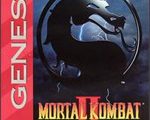
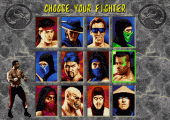
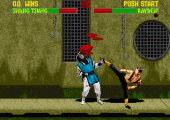
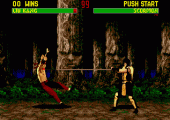
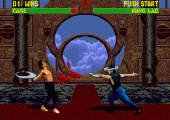
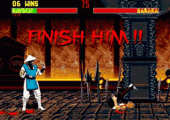
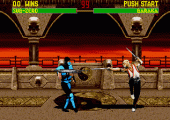
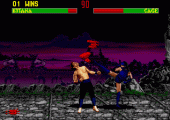
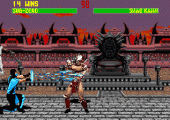
Recent Comments